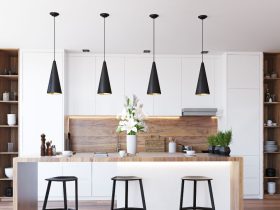The perfect kitchen organisation – everything at your fingertips Optimising the organisation of your kitchen isn’t just about finding a place for all necessary utensils and supplies. For effective work and enjoyment of your kitchen, it’s also essential to consider the layout of pathways, as well as ergonomic and time-saving solutions. After all, nothing is more frustrating than having to constantly walk from A to B while cooking or not being able to find what you need in a cluttered drawer. With functional and practical interior design, you’ll quickly find what you need, whether you’re planning a new kitchen or optimising an old one.
The Best Kitchen Layout for Short Working Paths
A kitchen is divided into different zones: preparation, cooking, washing up and waste separation, and storage. For quick processes, the areas for preparation, cooking, and cleaning should be within easy reach of each other. Often during kitchen planning, customers ask us whether dishes and cutlery should be stored closer to the dining table or the dishwasher. Generally, it’s practical to store dishes near the dishwasher, so they can be put away directly after washing. However, if little hands are eagerly helping set the table, a shorter path to the dining table makes sense.
Ergonomic Working Height in the Kitchen
It’s important that your work surface is large enough to prepare food. However, ergonomic working height is almost more crucial. After all, you don’t want to develop back problems when chopping, stirring, and kneading. That’s why we recommend adjusting the height of the work surface to your body size. Appliances like ovens or dishwashers should also be planned at working height. Another tip for ergonomic kitchen organisation is to avoid storing heavier items too low or high. Frequent bending or stretching can unnecessarily strain your back. Store things you seldom need there.
Organising Kitchen Drawers Sensibly
Try to store your tools and utensils in the appropriate kitchen zone, such as pots and pans near the cooker, dish towels by the sink, knives, boards, and peelers in the preparation area, etc. There are various organising systems for kitchen drawers made from solid wood, plastic, or metal. Depending on preference, the drawer inserts can also be adjustable. This helps maintain an overview and bring order to the notorious “junk drawer”. Another tip is to label storage locations. This way, it’s clear where everything belongs – no matter who’s unloading the dishwasher.
Kitchen Cabinets – Effectively Using Storage Space
Yes, classic kitchen cabinets and tall units are good storage options. However, depending on the kitchen layout, it’s worth considering other models too. A pull-out larder unit with a fully extendable interior provides easily accessible storage and is available in a lower version. With a narrow full-extension right next to the cooker, you have essential items like oil or the pepper mill right at hand. And dead corners come to life with corner cabinets – from classic carousels to modern swivel solutions. Our tip: Transfer spices from plastic packets into jars – it’s clearer. Instead of spice containers, you can also use old jam jars.
Accessories for the Kitchen Niche – Untapped Potential
The kitchen backsplash is often seen merely as a means to an end: it protects the wall from grease and water splashes. Yet, the kitchen niche can offer so much more. More and more kitchen manufacturers are therefore focusing on equipment for the kitchen niche. What’s the result? Holders and storage options for knives, spices, cookbooks, cooking utensils, and herb pots, with which you have everything you need at the cooker or work area within reach. The kitchen backsplash also offers space for additional lighting elements. With elegant light strips or spotlights, you can ensure optimal illumination of your work surface.
Storing Kitchen Appliances Space-Efficiently
Whether it’s a Thermomix, mixer, blender, or rice cooker – ideally, your kitchen offers space for your kitchen machines. But do they need to take up permanent space on the work surface? No, because there are other ways! With a lifting column, you can bring the appliance up from the cupboard at the push of a button. Another alternative is a foldable bread slicer that disappears like a drawer in the kitchen cupboard after use. And one more extra tip for the most important appliance: the fridge. With a practical turntable, the problem of not being able to reach food at the back of the fridge is finally solved.

















Leave a Reply